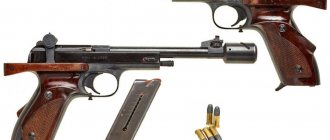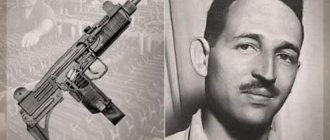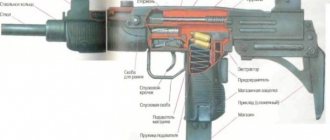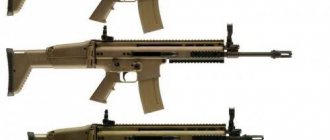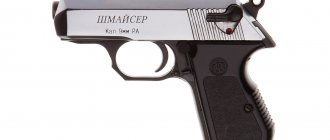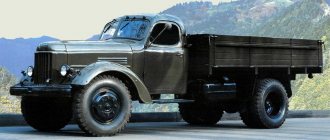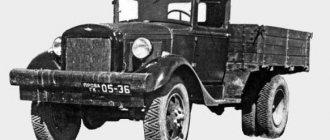Interesting facts about PM
We've talked enough about the 9mm traumatic pistol. Now let's return to the classic PM and tell you some interesting facts - they will probably be of interest to many readers.
Let's start with the fact that it was the Makarov pistol that became the world's first weapon to go into space. Yes, yes, it was he who was present in every pack designed for the Vostok crew members. It was subsequently replaced by a specially designed multi-function shotgun.
The State Unitary Enterprise Instrument Design Bureau still lists the PM, which was tested here in 1949. Having fired 50 thousand rounds of ammunition and more than a considerable age, it still retains its combat properties.
What will replace it?
Any weapon, even the most modern, becomes obsolete over time. And the Makarov pistol is no exception. Although it still remains in service with many countries, Russia is gradually abandoning it, switching to the more modern Yarygin pistol. Developed in 1993, it passed all tests and was put into service only 10 years later - in 2003. Designed for the 9 x 19 mm caliber, it has almost all the advantages of the PM, but lacks some of its disadvantages. For example, the range of confident combat and accuracy have increased. In addition, the special design of the magazine allows it to hold up to 18 rounds, which is a very important advantage.
However, the PM has not completely given up its position - it is still used by many military and police officers in our country, remaining a true legend.
What were the requirements for weapons?
Since it was planned to create millions of copies to arm the police and army in the largest country in the world, there were many requirements for weapons.
Then it was decided to put two pistols into service - one for special operations (this role was assigned to the proven APS - the Stechkin automatic pistol), and the second for constant wear. Of course, it had to be compact - officers and warrant officers had to constantly carry weapons both on their belts and in a holster for concealed carry.
The proven TT (Tula Tokarev) was not suitable. On the one hand, it had quite large dimensions. On the other hand, it did not have a fuse (it appeared later on some modifications, and the TT was produced in many places - from Poland and Romania to China and Pakistan), which increased the danger of use.
An important role was played by the fact that the population still had a large amount of ammunition in its hands. Not all captured weapons and ammunition issued for wartime were handed over by business people. Therefore, one of the main requirements was to create a pistol for cartridges not 7.62 (which was the TT), but 9-mm caliber. Many experts, using the captured Walter PPK during the war, appreciated this pistol and caliber.
It had many advantages, especially for use by the police in populated areas. Firstly, the 9mm bullet had a significant stopping effect. Secondly, the penetrating ability was low - there was no fear that the bullet would pierce the thin partitions and injure a stranger accidentally hiding behind them.
As a result, it turned out that it was the 9-mm Makarov pistol that fully met all the requirements.
Main disadvantages
Unfortunately, any weapon, even the most advanced, will have some drawbacks - designers always have to sacrifice one for the other.
Of course, the 9-mm Makarov pistol was no exception. PM is often accused of low accuracy. This is indeed a problem - in the pursuit of maximum compactness, the sighting line has been significantly reduced. This made it more difficult to aim. However, during testing, the pistol confidently “places” bullets from a distance of 25 meters into a circle with a radius of 75 millimeters. Therefore, even a not very trained person can easily hit a chest target from such a distance. Well, experienced officers who have undergone special training confidently place 3 bullets into a ten mark from 25 meters - a tiny circle with a diameter of about 25 millimeters.
The short combat distance has already been mentioned. However, all 9 mm pistols suffer from this - the PM is not an exception here. But for the needs of guards, about 25 meters is more than enough.
But the objective drawback is the extremely inconvenient latch for removing the magazine. Alas, while in many other pistols you can easily “snap out” an empty magazine with one hand, and instantly push a full one into the grip with the other, this technique will not work with the PM. You have to use both hands to hold the pistol with one and at the same time remove the magazine with the other.
Today, among weapon lovers, it is generally quite fashionable to criticize the Makarov pistol, comparing it with the Walter P99, various modifications of the Glock, the latest versions of the Beretta and others. However, when entering into such a discussion, we should not forget that it was developed 70 years ago, when these pistols had not even been heard of. Of course, during such a time, shooting has gone far ahead.
Rating of traumatic pistols
When compiling the review, injuries from popular brands that are available in the retail chain were compared. Ergonomics, accuracy of fire, and availability of ammunition were studied. Reviews of traumatic pistols from ordinary users and the opinions of special services specialists were taken into account. The main attention was paid to the following parameters:
- Purpose – for self-defense, use by security structures;
- Caliber – affects the energy of the shot, determines the availability of ammunition;
- Volume of shots - the number is limited by the size of the magazine;
- Barrel resource – limits the intensity of use.
Unreliable trigger mechanism, low shooting accuracy, misfires - such models were excluded from our rating.
PM for civilians
Short-barreled rifled weapons in our country are the prerogative of the military, police, bodyguards, as well as officers and deputies who have award-winning weapons and the corresponding documents for them.
However, ordinary citizens also want to be able to protect themselves and their homes. Especially for them in 2004, a special Makarov traumatic pistol (9 mm) was developed - IZH-79-9T. It received a name similar to the original - “Makarych” - and could be purchased by anyone willing to take the appropriate courses and provide storage conditions.
It became the first traumatic weapon that copied the appearance of the PM - even a specialist would not be able to immediately distinguish what the enemy was holding in his hands: a real pistol or a traumatic weapon. Even the popular traumatic 9-mm pistol Jorge was born later - only in 2006. In addition, in appearance it did not at all resemble a Makarov pistol - its design was taken from the Fort.
Of course, “Makarych” did not fire full-fledged live ammunition. It was intended for completely different ones, the same as those used by the owners of many other traumatic pistols - 9 mm RA (from the German Pistole Automatik - automatic pistol). The main difference between this ammunition was the bullet made of plastisol or rubber - soft, elastic materials. Externally, the cartridge resembles a combat one. But it is impossible to shoot from the Makarych using a full-fledged 9 x 18 mm cartridge - there were two protrusions in the barrel, located opposite each other at some distance. A malleable rubber bullet squeezed between them at high speed. A metal one will simply rip apart the barrel when you try to fire a shot.
Of course, such weapons immediately aroused serious interest. After all, any man wants to protect himself and his loved ones anywhere and at any time. And doing this with a pistol (even if it’s not even a combat pistol, but just a shooting 9-mm PA pistol) is much easier than using a knife, baton, gas spray or bare hands. Quite a lot of trauma items were sold out in a short time. Many users noted a number of important advantages. First of all, the external resemblance to a real weapon. Removing a traumatic pistol from a holster in a dark alley where he was met by suspicious persons, a law-abiding citizen can be sure that opponents will not be able to distinguish whether the weapon is real or not. It is important that they are also structurally similar. That is, a person who has experience in handling PM will easily master the Makarych, and vice versa. At the same time, he was also extremely reliable.
Alas, there were also disadvantages. First of all, the design is not the most convenient, completely adopted from the original pistol. In addition, the quality of the cartridges cannot be called high enough. More than once there have been cases when a person, in self-defense, shot a drunken attacker in the chest, legs or arms, but thereby only inflamed him. A shot in the head could well result in the death of the attacker, which would put the defender in a very awkward position. Alas, Jorge’s 9-mm pistol, for example, and many other injuries have the same drawback.
In addition, a bullet fired from such a weapon, unlike a real rifled pistol, does not receive rifling when flying through the barrel. As a result, if a person was killed with a traumatic weapon, forensic analysis will not be able to link the found bullet to a specific registered (if any) pistol. This significantly complicates the work of internal affairs officers, allowing criminals to escape punishment.
Subsequently, “Makarych” was discontinued, but was replaced by IZH-79-9TM, MR-79-9TM, MR-80-13T and others. However, they never completely got rid of the shortcomings inherent in the first sample.
Gas-based 9-mm pistols based on the PM were also produced, but they were not as widespread as the traumatic ones listed above. Their main feature is the use of special cartridges that do not have a bullet - they are replaced by special capsules containing tear gas. The advantage is the direction of action - you don’t have to pay attention to the direction of the wind, which can cause serious problems when using a gas spray. The downside is low efficiency, especially if you use this weapon against drunk people or animals.
Performance characteristics
The first thing that catches your eye when looking at the PM is its compactness. Indeed, its total length is 161 millimeters - versus 195 millimeters for the TT that was previously in service.
He also gained significantly in weight. With a full magazine, it weighs only 810 grams, compared to its predecessor - 940 grams.
The rest of the performance characteristics of the 9 mm Makarov pistol are also very good.
The stopping effect was excellent. Especially when the decision was made to abandon the use of the 9 x 17 mm cartridge used in Walther pistols in favor of a specially developed 9 x 18 mm. When hit, the massive, blunt-nosed bullet caused terrible damage, putting the criminal into a state of painful shock and not allowing him to resist.
The magazine holds 8 rounds - quite enough for a short street battle or indoor shootout. And for more, pistols are not used. Although theoretically the maximum range is considered to be 50 meters, in practice this distance is reduced to 20-25 meters. But for certain purposes this is enough - in cities, police officers rarely have to shoot at a long distance.
The initial speed of the bullet is 315 meters per second, which, combined with a mass of 6 grams, allows it to cause serious damage when hit.
Here, perhaps, are all the most important performance characteristics of the 9-mm Makarov pistol. Now let's talk about its main advantages.
